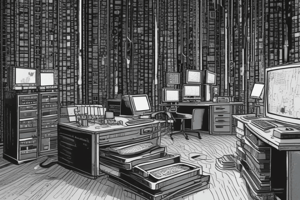Podcast
Questions and Answers
Which of these is a valid byte? (Select all that apply)
Which of these is a valid byte? (Select all that apply)
How many possible values can we have with 8 bits?
How many possible values can we have with 8 bits?
Why did UTF-8 replace the ASCII character-encoding standard?
Why did UTF-8 replace the ASCII character-encoding standard?
What is the highest decimal value we can represent with a byte?
What is the highest decimal value we can represent with a byte?
What is the decimal value of the binary value 0110 0011?
What is the decimal value of the binary value 0110 0011?
Who invented the development of the earliest programmable loom?
Who invented the development of the earliest programmable loom?
It took the powerful insights of a mathematician named _________ to realize the true potential of the analytical engine.
It took the powerful insights of a mathematician named _________ to realize the true potential of the analytical engine.
A(n) _____ is a series of steps that solve specific problems.
A(n) _____ is a series of steps that solve specific problems.
What cards had holes in them that were historically used to store data?
What cards had holes in them that were historically used to store data?
How did Charles Babbage use punch cards?
How did Charles Babbage use punch cards?
Who developed a series of machines that are now known as the greatest breakthrough on our way to the modern computer?
Who developed a series of machines that are now known as the greatest breakthrough on our way to the modern computer?
What is the keyboard layout that most of the world uses today?
What is the keyboard layout that most of the world uses today?
What is an Abacus?
What is an Abacus?
Who took the first major step toward the invention of the mechanical calculator in the 17th century?
Who took the first major step toward the invention of the mechanical calculator in the 17th century?
Blaise Pascal's foundational operations were later used in what industry?
Blaise Pascal's foundational operations were later used in what industry?
What had historical significance in the development of computers?
What had historical significance in the development of computers?
What did Alan Turing do?
What did Alan Turing do?
What innovation replaced the punch cards?
What innovation replaced the punch cards?
How did vacuum tubes help with moving data?
How did vacuum tubes help with moving data?
How did a magnetic tape work?
How did a magnetic tape work?
What's one of the earliest forms of general-purpose computers?
What's one of the earliest forms of general-purpose computers?
What replaced vacuum tubes?
What replaced vacuum tubes?
Flashcards are hidden until you start studying
Study Notes
Byte and Binary Basics
- A byte consists of eight bits, valid binary values include 11011011 and 00000000.
- With 8 bits, we can represent 256 possible values, ranging from 0 to 255.
- UTF-8 encoding replaced ASCII because it can represent characters using more than one byte, enabling a broader range of character types like emojis.
- The highest decimal value represented by a byte is 255, as decimal values account for zero.
- The binary representation of the ASCII letter "c" is 0110 0011, equivalent to the decimal value 99.
Historical Innovations
- Joseph Marie Jacquard invented the programmable loom, utilizing punched cards for designing fabric patterns.
- Ada Lovelace recognized the potential of the Analytical Engine, creating the first algorithm and laying the groundwork for programming.
- Charles Babbage, known as the father of computers, developed the Difference Engine, inspired by Jacquard's loom system.
Computing Milestones
- The abacus dates back to 500 BC and is recognized as one of the earliest computing tools.
- Blaise Pascal created the mechanical calculator in the 17th century, capable of basic arithmetic operations and fostering future innovations.
- During World War II, advancements in computing were catalyzed by the demand for cryptography, utilizing early computers for code-breaking.
Data Storage Practices
- Punch cards were historically used for data storage but were limited due to their cumbersome management.
- Magnetic tape replaced punch cards, allowing for more reliable and larger data storage solutions.
Electronic Components Evolution
- ENIAC, one of the earliest general-purpose computers, utilized around 17,000 vacuum tubes and occupied significant physical space.
- Vacuum tubes were eventually replaced by transistors, which are smaller, more efficient, and capable of performing the same functions.
Cryptography and Security
- Cryptography is essential for secure communications and saw significant development through wartime code-breaking efforts led by mathematician Alan Turing.
- Turing's contribution in cracking the Enigma machine helped illustrate the potential and importance of computation in warfare.
Modern Keyboard Layout
- The predominant keyboard layout used worldwide is QWERTY, which has become standard in contemporary computing.
Studying That Suits You
Use AI to generate personalized quizzes and flashcards to suit your learning preferences.




